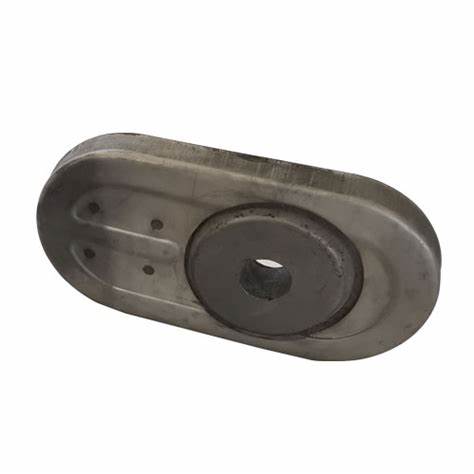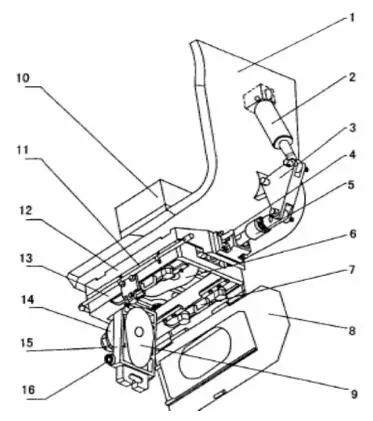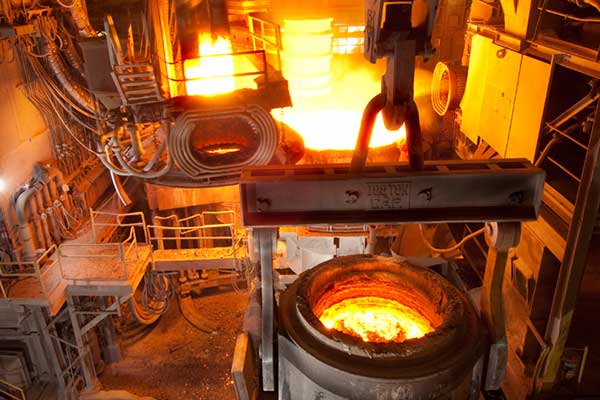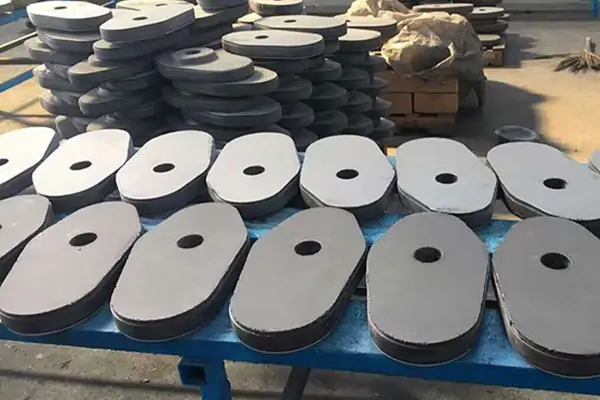Выдвижная насадка ковша является важной системой управления производством стали.. Если в системе протекает сталь во время использования, Это серьезно ограничит стабильное и плавное производство и угрожает безопасности персонала и оборудования. В этой статье анализируются различные факторы, которые влияют на утечку системы пластинку с огнеупорным горло.

Анализ причины утечки стали из пластины с упорной ворот.
1. Утечка пластины для скольжения, вызванная механическими причинами
Из -за частичной деформации кронштейна или использования некоторых источников, Сила зажима с обеих сторон противоречит, в результате неравномерного поверхностного давления между двумя слайд -кирпичами, Одна сторона подвержена большей силе, и другая сторона подвержена меньшей силе. Когда давление расплавленной стали превышает поверхностное давление с обеих сторон между двумя слайдами, расплавленная сталь будет входить между двумя поверхностями слайда, заставляя слайд зажимать сталь или утечку стали.

Схематическая диаграмма Пластина для ворот.: 1. Ковша стена; 2. Гидравлический цилиндр; 3. Штатив; 4. Поддерживать; 5. Потянуть стержень; 6. Верхний слайд; 7. Нажающая часть; 8. Охраняемая тарелка; 9. Нижний слайд; 10. Водяной базовый кирпич; 11. Холодная воздушная труба; 12. Квадратная нижняя пластина; 13. Кронштейн; 14. Внутренний рукав в нижней части воды; 15. Скользящая тележка; 16. Троллейное скользящее колесо
Из -за падения ползунка или ослабления нижнего вращающегося рукава, давление на поверхность пластины недостаточно, что может легко привести к тому, что поверхность пластины зажимает сталь, когда поток контролируется во время процесса. По мере усиления зажима поверхности пластины усиливается, Разрыв между слайд -пластинами постепенно увеличивается, и, наконец, вызывает утечку стали. Падение слайдера заставляет тележку не может поддерживать горизонтальную работу во время работы, в результате пробелы между слайд -пластинами; Когда нижний вращающийся рукав распущен, Нижняя слайд -пластина будет тонуть, приводя к зазорам между поверхностями пластины.
Стальная утечка, вызванная ковром

⑴ При наличии стали, обработанной кальцием, с высоким уровнем манганской стали, Верхняя вода и слайд -кирпичи имеют плохую коррозионную устойчивость, Вход воды и слайд быстро расширяются, и эффективный ход слайда становится меньше, который может легко привести к выходу из -за контроля или поверхности пластины зажать сталь.
⑵ Верхние и нижние слайд-кирпичи имеют низкую высокую силу или плохую сопротивление “тепловой удар”. До того, как слайд будет вылить, Когда температура поверхности пластины (~ 350 ℃) начинает залить сталь, Заливное отверстие внезапно контактирует с высокой температурной расплавленной сталью (~ 1580 ℃) и подвергается сильным “тепловой удар”. Внешняя заливающая отверстие создает растягивающее напряжение, превышающее прочность слайда, образуя радиальные трещины, центрированные на заливном отверстии. Появление трещин ускоряет химическую эрозию, И в то же время, Реакции химической эрозии способствуют образованию и расширению трещин (в тяжелых случаях, Трещины просачивают сталь и утечку стали).
⑶ Рабочие поверхности верхних и нижних слайдов имеют плохую высокотемпературную устойчивость к износу (Слайд -материал имеет плохую устойчивость к окислению, или верхние и нижние слайды имеют плохую посадку, Разрыв слишком большой, и воздух вдыхается во время заливки стали приводит к окисленности скользящей поверхности, а прочность уменьшается), И скользящая поверхность легко “грубый”. После проникновения расплавленной стали, тот “шероховатый” явление усугубляется при толчке и тяге, и устойчивость к трению слайд -пластины увеличивается. В тяжелых случаях, Утечка стали может возникнуть между скользящими поверхностями. Рефрактерный материал, используемый для слайд-пластины, контактирует с высокотемпературной расплавленной сталью и шлаком во время процесса, и происходит серия химических реакций, вызывая химическую эрозию.
Утечка стали из пластины для затвора ковша, вызванная неправильной работой
⑴ Работа процесс сборки, Есть в основном следующие причины.
①fter верхний сопло собран, Нижняя форсунка должна быть выпечена, чтобы увеличить прочность между верхним соплом и кирпичом сиденья, Чтобы избежать прижимания верхнего сопла в верхнюю слайд -пластину во время использования без выпечки, в результате пробела между верхней формочкой и слайд -пластиной.
② Когда грязевая подушка зажимается на верхней слайд -пластине, Из -за разницы в визуальном значении разрыва, Грязевая площадка слишком мало или слишком много. Когда грязевая площадка слишком мало, есть зазор между верхней форсункой и верхней слайд -пластиной, что может вызвать утечку стали между верхней формочкой и верхней слайд -пластиной или стальным зажимом между поверхностями пластины. Этот вид утечки стали более вреден. После утечки происходит на ранней стадии, Он должен быть обработан как можно скорее, чтобы избежать утечки стали со всех сторон на более поздней стадии, сжигание болтов с завязкой механизма и сжигание механизма; Когда грязевая площадка слишком много, Легко привести к разрыву поверхности слайд -пластины. Во время процесса заливки, расплавленная сталь образует стальные зажимы на трещинах, и утечка стали будет вызвана после того, как зажимы водяных сопло будут вытянуты несколько раз, чтобы расширить.
③ Высокотемпературная прочность кирпича сиденья насадки низкая. При использовании пневматического выбора, чтобы нагреть верхнюю форсунку кирпича ликова, Пневматическая головка для кирки часто повреждает сиденье кирпич, привести к увеличению кирпича сиденья в диаметре, а промежуток между кирпичом сиденья и кирпичом верхнего сопла. При наличии расплавленной стали, расплавленная сталь образует вихрь на сиденье кирпич. Под влиянием промывания расплавленной стали, расплавленная сталь легко проникает в зазор, вызывая утечку стали вокруг кирпича верхней форсунки.
④ Нижний сопло кирпит во время использования. Когда кирпич нижнего сопла подвергается воздействию стали, У него будут горизонтальные трещины под воздействием теплового напряжения. Под действием давления расплавленной стали, Трещины постепенно расширяются в трещины, И расплавленная сталь просачивается из них. В тяжелых случаях, Рефрактерный материал под трещинами разрывается из -за ее собственной силы тяжести и давления расплавленной стали.

⑵ Когда расплавленная сталь заливается, спеченный слой дренажного песка слишком толстый. Когда слайд -пластина полностью открыта, Стопленный слой ломается, и сталь появляется, когда течет, заставляя скользящее колесо троллейбуса придерживаться стали. Во время процесса заливки, Прилипающая сталь разрушает баланс давления механизма, Увеличивает зазор на поверхности пластины, и вызывает несчастные случаи.
⑶ Работа в производственном процессе, Из-за аварии на одном месте в квадратной заготовке, Стальное время рисования было продлено, Большой ковш был полупрогрозным в течение долгого времени, и скользящее сопло часто открывалось и закрыто, приводя к серьезной эрозии поверхности пластины. Когда раздвижное сопло было полубеск, Нижний слайд -кирпич был сильно подшипен расплавленной сталью из -за перехвата расплавленной стали. Через долгое время, Канавки будут сформированы на слайд -кирпичи, и на поверхности нижнего слайда появятся канавки в форме подковы. Когда ковш был закрыт, расплавленная сталь конденсирована в канавке, в результате стальной зажатой между двумя слайдами. Кроме того, количество времени управления потоком было относительно частым, и тенденция стального сэндвича была относительно быстрой, которые были подвержены несчастным случаям на утечке стали на более поздней стадии литья (Фигура 2).
 Группа Жуншэн
Группа Жуншэн

Вичат
Сканируйте QR-код с помощью WeChat